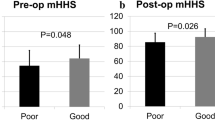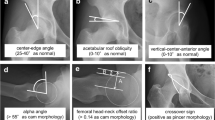Abstract
Pathology of the acetabular labrum plays an increasing role in the treatment of hip pain. Hip arthroscopy has proven its clinical value as a useful procedure for successful treatment of labral tears. Until today, only a few studies have investigated the influence of articular cartilage defects on the clinical outcome of partial arthroscopic labrum resection in a larger patient population. We prospectively evaluated patients with an intraoperatively proven labral lesion/tear without any radiological and arthroscopical sign of a concomitant bony femoroacetabular impingement or hip dysplasia for a minimum postoperative follow-up of 2 years. Cartilage defects were classified according to Outerbridge and divided into two subgroups: Outerbridge ≤ 1 and Outerbridge ≥ 2, respectively. To evaluate combined results, various established scoring systems (visual analogue scale, modified Harris Hip Score, Larson Hip Score) were used. Out of 54 originally enrolled patients, 50 individuals (29 female, 21 male) with a median age of 33 years (range 15–49) were available for follow-up after a mean of 34 (range 24–48) months. At follow-up, the total study population experienced significant improvement in pain and in the combined evaluation scales (Larson Hip Score/MHHS). When patients were categorized into two subgroups, either with intraoperatively present or absent articular cartilage defects, our data indicated that subjects with no degenerative changes of the articular cartilage surface significantly improved in the applied clinically scoring systems. In contrast, in patients with an articular cartilage lesion during hip arthroscopy score values had a tendency to be unimproved or even deteriorated at follow-up. Regression analysis revealed a significant negative correlation between postoperative outcome and the grading of the coexistent articular cartilage defect. On the basis of our investigation, we conclude that partial arthroscopic resection of a torn labrum without attending bone deformity (dysplasia or femoroacetabular impingement) can reveal good and satisfied results. Depending on the extent of a coexisting articular cartilage defect subjective clinical results are compromised.







Similar content being viewed by others
References
Baber YF, Robinson AH, Villar RN (1999) Is diagnostic arthroscopy of the hip worthwhile? A prospective review of 328 adults investigated for hip pain. J Bone Joint Surg (Br) 81:600–603
Byrd JW, Jones KS (2000) Prospective analysis of hip arthroscopy with 2-year follow-up. Arthroscopy 16:578–587
Christensen CP, Althausen PL, Mittleman MA, Lee JA, McCarthy JC (2003) The nonarthritic hip score: reliable and validated. Clin Orthop Relat Res 406:75–83
Dienst M, Godde S, Seil R, Hammer D, Kohn D (2001) Hip arthroscopy without traction: in vivo anatomy of the peripheral hip joint cavity. Arthroscopy 17:924–931
Dienst M, Seil R, Godde S et al (2002) Effects of traction, distension, and joint position on distraction of the hip joint: an experimental study in cadavers. Arthroscopy 18:865–871
Dorrell JH, Catterall A (1986) The torn acetabular labrum. J Bone Joint Surg (Br) 68:400–403
Eijeer H, Leunig M, Mahomed N, Ganz R (2001) Cross-table lateral radiographs for screening of anterior femoral head-neck offset in patients with femoroacetabular impingement. Hip Int 11:37–41
Espinosa N, Rothenfluh DA, Beck M, Ganz R, Leunig M (2006) Treatment of femoro-acetabular impingement: preliminary results of labral refixation. J Bone Joint Surg (Am) 88:925–935
Farjo LA, Glick JM, Sampson TG (1999) Hip arthroscopy for acetabular labral tears. Arthroscopy 15:132–137
Ferguson SJ, Bryant JT, Ganz R, Ito K (2000) The influence of the acetabular labrum on hip joint cartilage consolidation: a poroelastic finite element model. J Biomech 33:953–960
Ferguson SJ, Bryant JT, Ganz R, Ito K (2000) The acetabular labrum seal: a poroelastic finite element model. Clin Biomech (Bristol, Avon) 15:463–468
Ferguson SJ, Bryant JT, Ito K (2001) The material properties of the bovine acetabular labrum. J Orthop Res 19:887–896
Ferguson SJ, Bryant JT, Ganz R, Ito K (2003) An in vitro investigation of the acetabular labral seal in hip joint mechanics. J Biomech 36:171–178
Ganz R, Parvizi J, Beck M, Leunig M, Notzli H, Siebenrock KA (2003) Femoroacetabular impingement: a cause for osteoarthritis of the hip. Clin Orthop Relat Res 417:112–120
Guevara CJ, Pietrobon R, Carothers JT, Olson SA, Vail TP (2006) Comprehensive morphologic evaluation of the hip in patients with symptomatic labral tear. Clin Orthop Relat Res 453:277–285
Kelly BT, Weiland DE, Schenker ML, Philippon MJ (2005) Arthroscopic labral repair in the hip: surgical technique and review of the literature. Arthroscopy 21:1496–1504
Khanduja V, Villar RN (2006) Arthroscopic surgery of the hip: current concepts and recent advances. J Bone Joint Surg (Br) 88:1557–1566
Kim KC, Hwang DS, Lee CH, Kwon ST (2007) Influence of femoroacetabular impingement on results of hip arthroscopy in patients with early osteoarthritis. Clin Orthop Relat Res 456:128–132
Konrath GA, Hamel AJ, Olson SA, Bay B, Sharkey NA (1998) The role of the acetabular labrum and the transverse acetabular ligament in load transmission in the hip. J Bone Joint Surg (Am) 80:1781–1788
Lage LA, Patel JV, Villar RN (1996) The acetabular labral tear: an arthroscopic classification. Arthroscopy 12:269–272
Larson CB (1963) Rating Scale for hip disabilities. Clin Orthop Relat Res 31:85–93
Leunig M, Casillas MM, Hamlet M et al (2000) Slipped capital femoral epiphysis: early mechanical damage to the acetabular cartilage by a prominent femoral metaphysis. Acta Orthop Scand 71:370–375
Mason JB (2001) Acetabular labral tears in the athlete. Clin Sports Med 20:779–790
McCarthy JC, Noble PC, Schuck MR, Wright J, Lee J (2001) The Otto E. Aufranc Award: the role of labral lesions to development of early degenerative hip disease. Clin Orthop Relat Res 393:25–37
McCarthy J, Noble P, Aluisio FV, Schuck M, Wright J, Lee JA (2003) Anatomy, pathologic features and treatment of acetabular labral tears. Clin Orthop Relat Res 406:38–47
McCarthy JC (2004) The diagnosis and treatment of labral and chondral injuries. Instr Course Lect 53:573–577
Miozzari HH, Clark JM, Jacob HA, von Rechenberg B, Notzli HP (2004) Effects of removal of the acetabular labrum in a sheep hip model. Osteoarthritis Cartilage 12:419–430
Murphy SB, Ganz R, Muller ME (1995) The prognosis in untreated dysplasia of the hip. A study of radiographic factors that predict the outcome. J Bone Joint Surg (Am) 77:985–989
Neumann G, Mendicuti AD, Zou KH, Minas T, Coblyn J, Winalski CS, Lang P (2007) Prevalence of labral tears and cartilage loss in patients with mechanical symptoms of the hip: evaluation using MR arthrography. Osteoarthritis Cartilage 15:909–917
O’Leary JA, Berend K, Vail TP (2001) The relationship between diagnosis and outcome in arthroscopy of the hip. Arthroscopy 17:181–188
Outerbridge RE (1961) The aetiology of chondromalacia patellae. J Bone Joint Surg (Br) 43:752–757
Petersen W, Petersen F, Tillmann B (2003) Structure and vascularization of the acetabular labrum with regard to the pathogenesis and healing of labral lesions. Arch Orthop Trauma Surg 123:283–288
Potter BK, Freedman BA, Andersen RC, Bojescul JA, Kuklo TR, Murphy KP (2005) Correlation of Short Form-36 and disability status with outcomes of arthroscopic acetabular labral debridement. Am J Sports Med 33:864–870
Robertson WJ, Kadrmas WR, Kelly BT (2007) Arthroscopic management of labral tears in the hip: a systematic review of the literature. Clin Orthop Relat Res 455:88–92
Santori N, Villar RN (2000) Acetabular labral tears: result of arthroscopic partial limbectomy. Arthroscopy 16:11–15
Seldes RM, Tan V, Hunt J, Katz M, Winiarsky R, Fitzgerald RH Jr (2001) Anatomy, histologic features and vascularity of the adult acetabular labrum. Clin Orthop Relat Res 382:232–240
Suzuki S, Kasahara Y, Seto Y, Futami T, Furukawa K, Nishino Y (1994) Arthroscopy in 19 children with Perthes’ disease. Pathologic changes of the synovium and the joint surface. Acta Orthop Scand 65:581–584
Tanzer M, Noiseux N (2004) Osseous abnormalities and early osteoarthritis: the role of hip impingement. Clin Orthop Relat Res 429:170–177
Wenger DE, Kendell KR, Miner MR, Trousdale RT (2004) Acetabular labral tears rarely occur in the absence of bony abnormalities. Clin Orthop Relat Res 426:145–150
Wiberg G (1939) Studies on dysplastic acetabula and congenital subluxation of the hip. Acta Chir Scand 83:1–135
Author information
Authors and Affiliations
Corresponding author
Rights and permissions
About this article
Cite this article
Streich, N.A., Gotterbarm, T., Barié, A. et al. Prognostic value of chondral defects on the outcome after arthroscopic treatment of acetabular labral tears. Knee Surg Sports Traumatol Arthrosc 17, 1257–1263 (2009). https://doi.org/10.1007/s00167-009-0833-x
Received:
Accepted:
Published:
Issue Date:
DOI: https://doi.org/10.1007/s00167-009-0833-x




